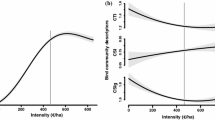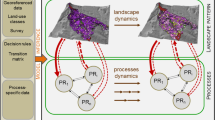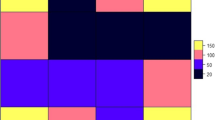Abstract
To manage agricultural landscapes more sustainably, we must understand and quantify the synergies and trade-offs between environmental impact, production, and other ecosystem services. Models play an important role in this type of analysis as generally it is infeasible to test multiple scenarios by experiment. These models can be linked with algorithms that optimise for multiple objectives by searching a space of allowable management interventions (the control variables). Optimisation of landscapes for multiple objectives can be computationally challenging, however, particularly if the scale of management is typically smaller (e.g. field scale) than the scale at which the objective is quantified (landscape scale) resulting in a large number of control variables whose impacts do not necessarily scale linearly. In this paper, we explore some practical solutions to this problem through a case study. In our case study, we link a relatively detailed, agricultural landscape model with a multiple-objective optimisation algorithm to determine solutions that both maximise profitability and minimise greenhouse gas emissions in response to management. The optimisation algorithm combines a non-dominated sorting routine with differential evolution, whereby a ‘population’ of 100 solutions evolves over time to a Pareto optimal front. We show the advantages of using a hierarchical approach to the optimisation, whereby it is applied to finer-scale units first (i.e. fields), and then the solutions from each optimisation are combined in a second step to produce landscape-scale outcomes. We show that if there is no interaction between units, then the solution derived using such an approach will be the same as the one obtained if the landscape is optimised in one step. However, if there is spatial interaction, or if there are constraints on the allowable sets of solutions, then outcomes can be quite different. In these cases, other approaches to increase the efficiency of the optimisation may be more appropriate—such as initialising the control variables for half of the population of solutions with values expected to be near optimal. Our analysis shows the importance of aligning a policy or management recommendation with the appropriate scale.








Similar content being viewed by others
References
Addiscott, T. M., & Whitmore, A. P. (1991). Simulation of solute leaching in soils of differing permeabilities. Soil Use and Management, 7(2), 94–102.
Bennett, E. M., Peterson, G. D., & Gordon, L. J. (2009). Understanding relationships among multiple ecosystem services. Ecology Letters, 12(12), 1394–1404. https://doi.org/10.1111/j.1461-0248.2009.01387.x.
Coleman, K., & Jenkinson, D. S. (2014). RothC-a model for the turnover of carbon in soil: model description and users guide (updated June 2014). Harpenden, UK: Lawes Agricultural Trust.
Coleman, K., Muhammed, S. E., Milne, A. E., Todman, L. C., Dailey, A. G., Glendining, M. J., & Whitmore, A. P. (2017). The landscape model: a model for exploring trade-offs between agricultural production and the environment. Science of the Total Environment, 609, 1483–1499. https://doi.org/10.1016/j.scitotenv.2017.07.193.
Cramer, W., Egea, E., Fischer, J., Lux, A., Salles, J. M., Settele, J., & Tichit, M. (2017). Biodiversity and food security: from trade-offs to synergies. Regional Environmental Change, 17(5), 1257–1259. https://doi.org/10.1007/s10113-017-1147-z.
Deb, K., Pratap, A., Agarwal, S., & Meyarivan, T. (2002). A fast and elitist multiobjective genetic algorithm: NSGA-II. IEEE Transactions on Evolutionary Computation, 6(2), 182–197. https://doi.org/10.1109/4235.996017.
Dury, J., Schaller, N., Garcia, F., Reynaud, A., & Bergez, J. E. (2012). Models to support cropping plan and crop rotation decisions. A review. Agronomy for Sustainable Development, 32(2), 567–580. https://doi.org/10.1007/s13593-011-0037-x.
Fischer, J., Meacham, M., & Queiroz, C. (2017). A plea for multifunctional landscapes. Frontiers in Ecology and the Environment, 15(2), 59–59. https://doi.org/10.1002/fee.1464.
Gourevitch, J. D., Hawthorne, P. L., Keeler, B. L., Beatty, C. R., Greve, M., & Verdone, M. A. (2016). Optimizing investments in national-scale forest landscape restoration in Uganda to maximize multiple benefits. Environmental Research Letters, 11(11), 114027. https://doi.org/10.1088/1748-9326/11/11/114027.
Groot, J. C. J., Yalew, S. G., & Rossing, W. A. H. (2018). Exploring ecosystem services trade-offs in agricultural landscapes with a multi-objective programming approach. Landscape and Urban Planning, 172, 29–36. https://doi.org/10.1016/j.landurbplan.2017.12.008.
Howe, C., Suich, H., Vira, B., & Mace, G. M. (2014). Creating win-wins from trade-offs? Ecosystem services for human well-being: a meta-analysis of ecosystem service trade-offs and synergies in the real world. Global Environmental Change-Human and Policy Dimensions, 28, 263–275. https://doi.org/10.1016/j.gloenvcha.2014.07.005.
Hu, H. T., Fu, B. J., Lu, Y. H., & Zheng, Z. M. (2015). SAORES: a spatially explicit assessment and optimization tool for regional ecosystem services. Landscape Ecology, 30(3), 547–560. https://doi.org/10.1007/s10980-014-0126-8.
Hughes, D. J., West, J. S., Atkins, S. D., Gladders, P., Jeger, M. J., & Fitt, B. D. L. (2011). Effects of disease control by fungicides on greenhouse gas emissions by UK arable crop production. Pest Management Science, 67(9), 1082–1092. https://doi.org/10.1002/ps.2151.
Kennedy, C. M., Hawthorne, P. L., Miteva, D. A., Baumgarten, L., Sochi, K., Matsumoto, M., Evans, J. S., Polasky, S., Hamel, P., Vieira, E. M., Develey, P. F., Sekercioglu, C. H., Davidson, A. D., Uhlhorn, E. M., & Kiesecker, J. (2016). Optimizing land use decision-making to sustain Brazilian agricultural profits, biodiversity and ecosystem services. Biological Conservation, 204, 221–230. https://doi.org/10.1016/j.biocon.2016.10.039.
Kindred, D. R., Milne, A. E., Webster, R., Marchant, B. P., & Sylvester-Bradley, R. (2015). Exploring the spatial variation in the fertilizer-nitrogen requirement of wheat within fields. The Journal of Agricultural Science, 153(1), 25–41. https://doi.org/10.1017/S0021859613000919.
Lark, R. M., Milne, A. E., Addiscott, T. M., Goulding, K. W. T., Webster, C. P., & O'Flaherty, S. (2004). Scale- and location-dependent correlation of nitrous oxide emissions with soil properties: an analysis using wavelets. European Journal of Soil Science, 55(3), 611–627. https://doi.org/10.1111/j.1365-2389.2004.00620.x.
Letourneau, D. K., Jedlicka, J. A., Bothwell, S. G., & Moreno, C. R. (2009). Effects of natural enemy biodiversity on the suppression of arthropod herbivores in terrestrial ecosystems. Annual Review of Ecology, Evolution, and Systematics, 40(1), 573–592. https://doi.org/10.1146/annurev.ecolsys.110308.120320.
Metcalfe, H., Milne, A., & Storkey, J. (2019). (paper in preparation). Ecology Letters.
O'Farrell, P. J., & Anderson, P. M. L. (2010). Sustainable multifunctional landscapes: a review to implementation. Current Opinion in Environmental Sustainability, 2(1-2), 59–65. https://doi.org/10.1016/j.cosust.2010.02.005.
Parsons, D. J., & Beest, D. T. (2004). Optimising fungicide applications on winter wheat using genetic algorithms. Biosystems Engineering, 88(4), 401–410. https://doi.org/10.1016/j.biosystemseng.2004.04.012.
Rawls, W. J. (1983). Estimating soil bulk density from particle size analysis and organic matter content. Soil Science, 135(2), 123–125.
Seppelt, R., Beckmann, M., Ceausu, S., Cord, A. F., Gerstner, K., Gurevitch, J., et al. (2016). Harmonizing biodiversity conservation and productivity in the context of increasing demands on landscapes. Bioscience, 66(10), 890–896. https://doi.org/10.1093/biosci/biw004.
Sethi, L. N., Panda, S. N., & Nayak, M. K. (2006). Optimal crop planning and water resources allocation in a coastal groundwater basin, Orissa, India. Agricultural Water Management, 83(3), 209–220. https://doi.org/10.1016/j.agwat.2005.11.009.
Shibu, M. E., Leffelaar, P. A., van Keulen, H., & Aggarwal, P. K. (2010). LINTUL3, a simulation model for nitrogen-limited situations: application to rice. European Journal of Agronomy, 32(4), 255–271. https://doi.org/10.1016/j.eja.2010.01.003.
Storn, R., & Price, K. (1997). Differential evolution-a simple and efficient heuristic for global optimization over continuous spaces. Journal of Global Optimization, 11(4), 341-359, doi: https://doi.org/10.1023/a:1008202821328.
Teillard, F., Doyen, L., Dross, C., Jiguet, F., & Tichit, M. (2017). Optimal allocations of agricultural intensity reveal win-no loss solutions for food production and biodiversity. Regional Environmental Change, 17(5), 1397–1408. https://doi.org/10.1007/s10113-016-0947-x.
Tilman, D., Cassman, K. G., Matson, P. A., Naylor, R., & Polasky, S. (2002). Agricultural sustainability and intensive production practices. Nature, 418(6898), 671–677. https://doi.org/10.1038/nature01014.
Todman, L. C., Coleman, K., Milne, A. E., Gil, J. D. B., Reidsma, P., Schwoob, M.-H., Treyer, S., & Whitmore, A. P. (2019). Multi-objective optimization as a tool to identify possibilities for future agricultural landscapes. Science of the Total Environment, 687, 535–545. https://doi.org/10.1016/j.scitotenv.2019.06.070.
Verhagen, W., van der Zanden, E. H., Strauch, M., van Teeffelen, A. J. A., & Verburg, P. H. (2018). Optimizing the allocation of agri-environment measures to navigate the trade-offs between ecosystem services, biodiversity and agricultural production. Environmental Science & Policy, 84, 186–196. https://doi.org/10.1016/j.envsci.2018.03.013.
Westmacott, R. N., & Worthington, T. (2006). Agricultural landscapes: 33 years of change: report of a study undertaken during 2005 on behalf of the countryside agency’s landscape, access and recreation division: countryside agency.
Wolf, J. (2012). User guide for LINTUL4 and LINTUL4V: simple generic model for simulation of crop growth under potential, water limited and nitrogen limited conditions (pp. 58). Wageningen UR, Wageningen.
Funding
Rothamsted Research receives grant-aided support from the Biotechnology and Biological Sciences Research Council (BBSRC) of the UK. This research was funded by the Biotechnology and Biological Sciences Research Council (BBSRC) Institute Strategic Programme (ISP) grants, ‘Soils to Nutrition’ (S2N) grant number BBS/E/C/000I0330, the joint Natural Environment Research Council (NERC), and the Biotechnology and Biological Sciences Research Council (BBSRC) ISP grant ‘Achieving Sustainable Agricultural Systems’ (ASSIST) grant number BBS/E/C/000I0130 ASSIST, using facilities funded by the BBSRC and by a Department for Environment, Food and Rural Affairs and EU collaborative project ‘Targets for Sustainable And Resilient Agriculture’ (TSARA), received as part of the FACCE-JPI Surplus initiative.
Author information
Authors and Affiliations
Corresponding author
Additional information
Publisher’s note
Springer Nature remains neutral with regard to jurisdictional claims in published maps and institutional affiliations.
Rights and permissions
About this article
Cite this article
Milne, A.E., Coleman, K., Todman, L.C. et al. Model-based optimisation of agricultural profitability and nutrient management: a practical approach for dealing with issues of scale. Environ Monit Assess 192, 730 (2020). https://doi.org/10.1007/s10661-020-08699-z
Received:
Accepted:
Published:
DOI: https://doi.org/10.1007/s10661-020-08699-z




